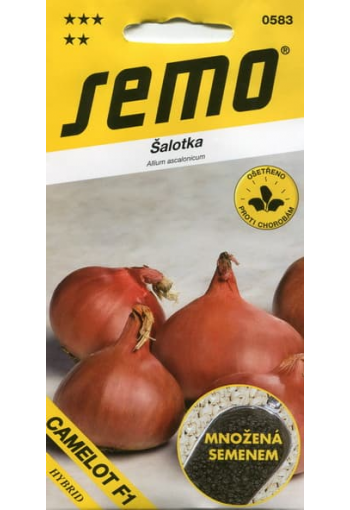Ex Tax: 1.47€
Fine and sweety taste.
A hybrid shallot that already in the year of sowing gives a ready-to-eat crop. Forms a large number of small onions covered with dark red dry scales. Juicy scales are white, very juicy and soft. Very well kept for use during late autumn and winter.
Shallots are an interesting alternative to other onions and are becoming increasingly popular for their distinctive flavor that doesn't overwhelm other foods. Differs in high dietary qualities, contains more, than onion of sugars, ascorbic acid, mineral substances and dry matters. Feather height - 35 cm, spread -15 cm.
The merely by seed multiplied variety is virusless. We need cca 4,5-5,5 g seed for 10 m2.
Agricultural technology.
Sowing in a permanent place, seeding depth - up to 1.5 cm. Placed in open, well-lit areas with fertile sandy loamy soil, fertilized in the previous year. Seeds are pre-soaked for a day in water, and then dried. After sowing, the topsoil is lightly compacted. Seeds germinate at +7°C. Before germination, do not allow the soil to dry out.
Care: weeding, loosening, timely watering.
* A distinctive feature of shallots is its early ripeness: after planting, it grows quickly, after 25-30 days the greens can be cut, and the bulb itself ripens in 70-80 days. The productivity of shallots is high. Greens can be harvested up to 5 kg/m2, and bulbs up to 3 kg/m2. In addition, the bulbs are cold-resistant: they can freeze, and after gradual thawing they can germinate as if nothing had happened.
An important quality is the ability to be stored well: it does not dry out, does not germinate at room temperature, and can be stored without problems until the next harvest.
This onion has a deep but short dormant period, so it is very convenient for winter and early spring forcing. And if shallots are planted in the ground in the fall, then in the spring its greens will be ready for use 10-15 days earlier than regular onion greens.
If you plant shallots in July-August, a wonderful harvest of greenery will ripen in the fall (this is unlikely to happen with onions).
In spring, shallots are planted as early as possible - just so that the ground warms up a little. When the soil is sufficiently moist and cold (+8+10°C), intensive root growth occurs, which outstrips leaf growth. Late planting is undesirable: the soil becomes dry and warm, as a result of which the growth of leaves will outpace the growth of roots, that is, the plants will begin to suffer from a lack of water and nutrients.
Scallion plants produce a large rosette of green leaves, so they require good light. The distance between rows should be 30-50 cm, between plants in a row 10-20 cm (the smaller the planting material, the higher the planting density). Shallots can be grown in a 20x20 cm or 30x30 cm pattern.
To obtain larger scallion bulbs, you need to cut them into several parts, so from one large onion, cutting off the “tail” and dividing the bulb into parts, you can get up to 10 planting units, from which 3-4-celled large families will grow up to 150-170 g .
The bulbs are planted to a depth of 5-6 cm, so that there is a 2-3 cm layer of soil above them. Planting too shallow can lead to the bulbs sticking out of the ground (especially on heavy soils).
If the planting material is buried, the new bulbs will not ripen well and become smaller.
How to care for shallots?
Be sure to loosen the soil around the plants to prevent crust formation. Of course, water and feed in the first half of the growing season. Fertilizing in July is ineffective (and nitrogen fertilizers are harmful).
In the first ten days of July, you can remove excess bulbs in the nest. To do this, you need to carefully rake the soil away from the plants and completely remove 2-3 branches in the area with the bulb, leaving 2-3 shoots (the bulbs will become larger).
Harvest shallots after lodging of leaves. You should not delay harvesting, as this will not increase the yield and reduce the shelf life of the bulbs. The leaves usually dry well and can be braided or, without cutting with scissors, simply picked off with your fingers and placed in a lattice box.
Shallots are best stored at a temperature of 0°C or +1°C and a relative humidity of 60-70%. If you have to store the shallots in a warm place, it is better to dust them with ash or chalk.
Eng.: Scallion. Bot.: Allium cepa L. var. ascalonicum.
Shallots are a spicy vegetable, a biennial herbaceous plant of the onion family. It is less pungent in taste compared to onions, more aromatic and fragrant compared to leeks.
The most delicious of all onions!
It is considered a gourmet onion and is included in many recipes in French cuisine. Used fresh as a seasoning for salads, soups, and appetizers.
Contains more sugars, ascorbic acid, and dry matter than regular onions.











